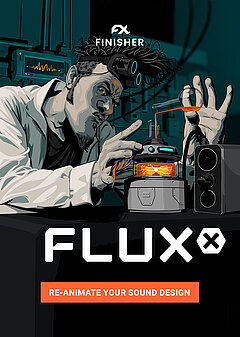How to Design a Glitch Beat
Build driving, ambient or avant garde grooves and create brand-new textures you’ve never heard before
MARCH 18TH, 2023
Aesthetic
Glitch music is a broad categorization, and it forces producers to think completely outside of other forms of electronic music such as EDM. The goal typically isn’t to create a thumping 4-to-the-floor beat, but rather a texture or palette for listeners to immerse themselves in — that’s not to say you can’t have a clear beat, or even an extremely intense one ... only that the end purpose is up to interpretation. The raw sound is often a mixture of retro sounds with futuristic / cut up acoustic ones, and you have to be ready for some heavy sample-diving or sound design, depending on how much you want to do from scratch. There’s a good chance you’ll need a lot of different short glitches and artifacts, so be prepared!
Retro samples are a great way to lay down the initial beat, and Beatmaker CIRCUITS is a great option for this — it has tons of pre-programmed MIDI grooves so you never have to get started from scratch, and the MIDI Drag & Drop feature allows you to freely modify them, giving you the speed and flexibility you need. The samples inside were created with some of the earliest drum machines from the 70s, giving you a warm vintage quality you can use as a bed to build off of. If you want to quickly make your sound more intense and modern, the Boost dial cranks up the sub and high end shimmer to give you “more” of everything — try automating this control to add an extra layer of glitchiness to the beat!
Beat
Unlike many other genres, there are no real conventions to follow here ... that said, if you want your glitch music to be fairly rhythmic and ambient, a good starting point is placing your kick on beat one and snare on beat 3. That leaves a ton of empty space to fill in, which is where you can have some real fun. Freely intersperse ultra-fast breaks with steady 8ths and 16ths, varying the rhythm while still keeping the gentle 1 - 2 pulse of the kick and snare. But fill it with what, exactly?
That can be hi hats and auxiliary percussion like normal, but the real intrigue of glitch music comes from experimenting heavily with different sounds — instead of hi hats, try electrical sounds, blips, fragmentations, anything you like! As long as it sounds like it belongs (and oddly enough, like it doesn’t at the same time), you can add anything you like. Richard Devine does a beautiful job of this; give a listen to this fine example:
It doesn’t all strictly have to be electronic in nature, either; you can add chopped up samples here and there with awesome results. Notes from acoustic instruments, running water, crackling, simple things you can record with a smartphone mic work perfectly for this; import them into your session, cut out the dead space, shape the envelope with fades and process to your liking!
If you’re feeling more adventurous and want to air more on the side of chaos, you can also take a multiple-bar segment of the beat, render it out and manipulate it from there. For example, you can stretch and compress the length, making the beat oscillate between ultra fast and normal speed. You can also chop up the beat into quarter note lengths, 8ths, or even smaller and rearrange them at will, switching things up a little each bar. There doesn’t need to be any rhyme or reason to this, either — you can make bizarre changes very quickly, and if it sounds good then it is good! In many ways, you have significantly more flexibility than you would with EDM, where your focus constantly needs to be on what will keep people moving and consistency is paramount.
Processing
Glitch music loves randomness. The more variation and complexity you can introduce while maintaining a unified vision for the song, the more fun you’ll be able to have! Once you have an idea for the beat in motion, you can pump out a ton of variations based only on the processing chain you layer on top. There are a few things you can look for here: One is motion. This can mean effects like tremolo, flanging, pan modulation and any other effects you can use to raise the energy and elevate the static elements of a song. You change an indefinite number of different effects together to do this, but if you want a simpler and faster approach, Finisher DYNAMO offers an incredibly diverse multi-effect collection in a single tool, allowing you to reshape your entire groove on the fly!
The more heavy-handed (but equally viable) approach is to demolish your beat and shred the rhythm and timbre apart mercilessly, which is especially useful if you’re not as concerned with preserving the groove. By using delays, granular processing, and a host of other techniques designed to re-imagine sounds, you can create tons of variations on a beat extremely quickly — Finisher FLUXX is a great way to automate ton of this process, and you can then render out the new material you create and cut it up into new rhythms and sounds. See how the idea of rendering and chopping keeps coming into play? You can even take this material, add more effects onto it, and render and chop it up again; there’s no limit to how many times you can repeat this cycle!
Wrapping up
Making glitch music can be tricky, in that there are few guidelines to what it should actually sound like. In some ways, it’s less of a genre and more so a suggestion for how to process and organize musical ideas — if you approach glitch music this way, you’ll have fewer limits on your creativity and your ability to express it.
It’s easy to fall into the trap of thinking you have to mix a bunch of disjointed ideas together, though; coherence and unity are critical, making everything feel like it belongs in the same arrangement. Nail this balance, however, and you'll be able to create awesome glitch music that listeners can get immersed in over and over again — try it out, don’t be afraid to experiment, and see how you can bring it all together!
About the Author
Harry Lodes is a copywriter, marketing consultant and content writer for audio and ecommerce brands. He lives in the Philadelphia area, releasing Eastern/Western hybrid EDM under the artist name KAIRI hearkening back to his roots in Berklee College of Music.
Stay up to date
Sign up and we’ll send you an e-mail with product news and helpful stuff every now and then. You may unsubscribe at any time.
Defy Limits
We develop software solutions that enable people to create, consume and interact with music.





